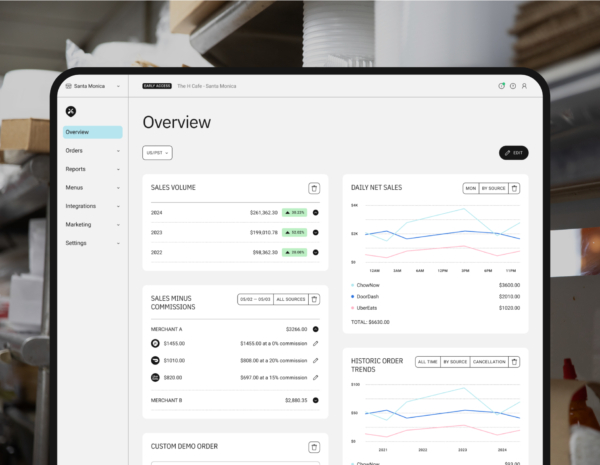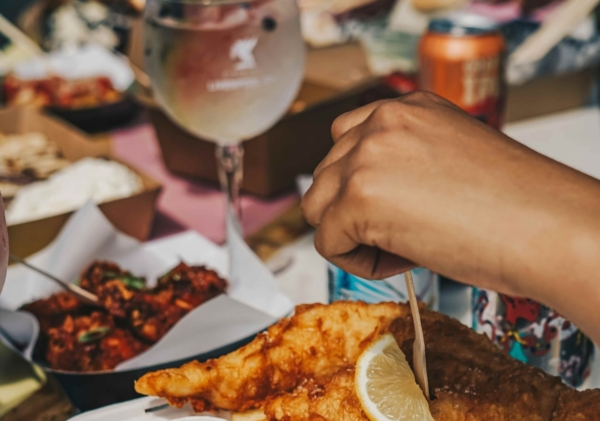ChatGPT For Restaurants: How to Use AI to Save Time On Marketing

Running your restaurant leaves little time for writing clever captions, drafting email updates, or answering the steady stream of guest feedback online. But marketing doesn’t stop just because you don’t have time for it.
This is where ChatGPT for restaurants can make a real difference in the quality and quantity of your marketing efforts.

If you’re at all intimidated by the thought of trying to use ChatGPT, don’t be—AI can help with daily marketing tasks like writing social media posts, refreshing menu descriptions, or even handling online reviews, and this article is going to teach you exactly how to use it like a pro. Think of it as a digital assistant that helps you save time while keeping your branding consistent and professional.
In this article, you’ll learn:
- How to generate content using real menu items, specials, and guest feedback
- Where to apply ChatGPT for quick, consistent posts, descriptions, and review replies
- Why building prompt templates will help you move faster with less effort
Using ChatGPT For Social Media Posts
Social media by nature needs fresh content constantly—between posting on different social media platforms, finding the right words to make your post compelling, and keeping a consistent voice, it’s easy for marketing to slip down your to-do list.
Here are a few ways ChatGPT can help:
Generate captions quickly
Instead of staring at a blank screen, you can generate Instagram captions or Facebook updates in seconds. All you need to do is plug in your real menu items or a daily special, and ChatGPT will turn them into short, engaging posts designed to entice customers.
Here’s what that could look like:

Tailor posts to fit your restaurant
ChatGPT ensures your content reflects your restaurant’s brand voice. Whether you’re promoting a seasonal menu or highlighting your signature dish, it can adapt to match the tone your target audience expects. This makes posts feel authentic and helps entice customers to stop by.
Saving time by batching posts in advance
By batching a week’s worth of social media posts in advance, you’ll save time while keeping your restaurant visible online. You can even turn these into a running content calendar that keeps promotions timely and relevant.
The real advantage is that you don’t have to reinvent the wheel every time you sit down to create social media posts. With the right prompts, ChatGPT makes it simple for independent restaurants to keep their feeds active, engaging, and aligned with their marketing campaigns, all while freeing you up to focus on running your business.
Writing Better Menu Descriptions With ChatGPT

Your menu is one of your most powerful marketing tools, but writing compelling dish descriptions that balance clarity with personality isn’t easy.
ChatGPT can help you turn the basics into words that gets customers excited while reflecting your unique style.
Turning basic dish details into compelling, guest-friendly descriptions
Start with the raw details—certain ingredients, preparation method, and serving style—and let ChatGPT create descriptions that make your dishes sound irresistible.
For example:

Adapting tone for different platforms
A description that works on a chalkboard menu might not read the same on delivery platforms or your restaurant website. ChatGPT can adjust your message to fit the channel, whether it’s short and snappy for a new menu board or more detailed and search-friendly for search engines.
Keeping language clear while avoiding overly generic messaging
One of the biggest challenges in menu writing is avoiding bland or overused terms. With the right prompts, ChatGPT can help you write original, easy-to-understand menu descriptions that stay true to your restaurant’s voice.
This makes it easier to highlight seasonal ingredients, accommodate dietary restrictions, and ensure customer satisfaction when guests order.
The more context you give, the more natural and appetizing the result will be for your guests. Don’t feel like you need to write like a tech person when creating prompts—just tell it exactly what you’re trying to do, adding in lots of details, and ChatGPT will understand what you’re trying to achieve.
Responding To Online Reviews More Efficiently
Online reviews can make or break a restaurant’s reputation, shaping how new customers perceive your business and affecting both your digital and physical foot traffic.
However, writing thoughtful replies takes time most restaurant owners don’t have. Using ChatGPT, though, you can respond quickly and professionally to a larger number of customer reviews while staying authentic to your brand.
Crafting polite, on-brand responses in less time
Instead of typing out every message from scratch, give ChatGPT a short summary of the review and ask it to create a reply. You’ll get polished text in seconds, which you can tweak before posting.
Personalizing replies by pulling from guest feedback
The most effective way to respond to customer reviews is to include details from the guest’s review in your prompt.
For example:

You can still customize the answer, but the bulk of the work is done, saving you time while ensuring every review gets acknowledged.
Maintaining professionalism when handling negative reviews
Dealing with criticism is tough, but ChatGPT can help you craft replies that strike the right balance between apology and resolution. Whether it’s a mix-up with which dish was delivered to the table or a delay with reservations, you can maintain a tone that protects your reputation while aiming for customer satisfaction.
Building diner trust through consistency and timeliness
When your replies are consistent and timely, it signals to customers that you value their feedback and are committed to excellent customer service. Over time, this helps reinforce loyalty and encourages more online reviews that highlight your strengths.
Creating Reusable Prompt Templates

One of the easiest ways to get long-term value from ChatGPT is by building a library of reusable prompts. Instead of starting from scratch every time you need to write a post, update your menu, or draft a message to your customers, you can rely on proven templates that save time and keep your communication consistent.
Why a prompt library saves time and keeps messaging consistent
A prompt library acts like a shortcut. Once you’ve crafted a few effective prompts that fit your brand voice, you can reuse them whenever similar tasks come up.
This not only helps you save time but also ensures your marketing campaigns stay clear, consistent, and aligned with the tone you want to share.

Templated ideas to get started
To get your feet wet, try out these prompts that we’ve put together and see how they work for your restaurant. You don’t have to use them word-for-word, but they should do the majority of the heavy lifting.
When you get comfortable with how ChatGPT works, try developing new ones that better fit your brand and operations.
Weekly email update template
Prompt:
“I run a [style of cuisine] restaurant and need help writing a short weekly update email to my guests. Keep it conversational and informative. This week’s highlights are: [insert seasonal menu changes, special events, or behind-the-scenes updates]. Write 2–3 paragraphs that feel friendly and keep my customers engaged.”
Seasonal campaign template
Prompt:
“Help me write a post to promote my [insert seaon] seasonal menu. Highlight the ingredient: [insert seasonal ingredient]. Make sure the post emphasizes freshness and encourages diners to come in while supplies last. Keep it short enough for social media but still descriptive enough to entice customers.”
Social media themes
Prompt:
“Write three Instagram captions that spotlight our signature dish, [insert dish name]. Use a tone that matches my restaurant’s style, which I’d describe as [insert a few words about your style—e.g., fun and casual, upscale and polished, family-friendly]. The captions should connect with my target audience and encourage engagement. Each caption should include a call to action that helps me encourage customers to visit or order.”
Tinker with each of these prompts till you get something you like, and if you’re having a hard time, just explain to ChatGPT the issue, and it will provide options to fix it.
Encourage staff to use templates
If marketing is a shared responsibility between you and your managers, a prompt library makes it easier for anyone on the team to generate content and stay on brand. This way, you’re not the only one responsible for writing every post or drafting every marketing campaign—your team can step in and help while keeping messaging consistent.
Making AI Feel Approachable And Actionable

For many restaurant owners, the idea of using artificial intelligence can feel intimidating.The technology itself is so advanced that it might seem like you need special training just to use it, but that couldn’t be further from the truth.
Start small with simple tasks
Pick one task that takes up too much of your time—like writing social media posts or drafting short descriptions for your online ordering menu items. Use ChatGPT to create a few options, then edit the results to match your style.
Build confidence as you go
As you experiment, you’ll notice where ChatGPT makes the biggest difference. Maybe it helps you prepare polished job descriptions when hiring new employees, or maybe it keeps your email updates sounding consistent without taking extra time.
Start with what feels useful, then build from there.
Scale up once you see results
Once you know which prompts deliver the desired result, you can expand. Build a simple plan:
- Use ChatGPT for social media and email
- Update your content calendar monthly with fresh ideas
- Create reusable prompts for seasonal demand or new menu launches
Over time, your prompt library will build, and you’ll have a system that produces great content while reducing the stress and volume of your workload.
The key is to not overthink it—treat ChatGPT like a digital assistant and you’ll quickly see it can help your restaurant stay visible, efficient, and responsive.

Why Now’s the Time to Put ChatGPT to Work in Your Restaurant
Now that tools like ChatGPT are widely accessible, there’s no reason to let everyday marketing tasks slow you down. Start small, stay consistent, and you’ll quickly see how AI can help your restaurant save time, connect with customers, and drive more revenue.
ChatGPT for Restaurants Frequently Asked Questions
How do I start using ChatGPT if I’ve never tried AI before?
Start with something small and familiar. Pick a simple task you already do often, like writing a thank-you reply to a customer review or drafting a caption for your daily special. Give ChatGPT clear details—such as the dish, occasion, or tone you’d like—and then edit the draft it provides. This way, you’ll build confidence without feeling overwhelmed.
Is ChatGPT free to use for restaurants?
Yes. ChatGPT offers a free version that works well for everyday tasks like writing posts or drafting short updates. There’s also a paid option with faster responses and more advanced tools, but the free version is enough to get started and see real value.
What are the best ChatGPT prompts for restaurants?
The best prompts are specific. Instead of asking, “Write a post for my restaurant,” include details like the dish name, ingredients, or type of event. For example:
- “Write a short Instagram caption promoting my Friday seafood special: grilled salmon with lemon butter.”
- “Draft a friendly response to a review where the guest complimented our service.”
- “Create a two-paragraph weekly email update sharing our new lunch hours and upcoming patio events.”
The more context you give, the better the results will be.
How can restaurants use ChatGPT?
Restaurants can use ChatGPT in many ways: writing menu descriptions, creating social media posts, drafting responses to reviews, or even preparing internal documents. It’s especially helpful for tasks that repeat often, since you can save time by reusing prompts and editing the output.
What’s the best way to train staff to use ChatGPT effectively?
Make it easy for your team by building a small library of ready-to-use prompts. For example, one prompt could be for drafting polite review responses, another for writing weekly updates, and another for announcing specials. Show staff how to fill in the blanks with your restaurant’s details, and they’ll be able to create content that stays consistent without needing extensive training.





